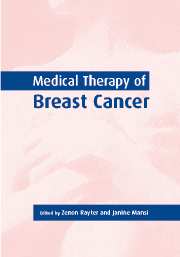Book contents
- Frontmatter
- Contents
- List of contributors
- 1 History of breast cancer therapy
- 2 Chemoprevention of breast cancer
- 3 Familial breast cancer
- 4 Hormone replacement therapy and breast cancer
- 5 Screening for breast cancer
- 6 The management of in situ breast cancer
- 7 Adjuvant systemic therapy
- 8 Adjuvant radiotherapy in the management of breast cancer
- 9 Predictors of response and resistance to medical therapy
- 9a Cell kinetic parameters and response to therapy
- 9b Predictors of response and resistance to medical therapy: endocrine therapy
- 9c Predictors of response and resistance to medical therapy: chemotherapy
- 10 Primary medical therapy in breast cancer
- 11 Medical therapy of advanced disease
- 12 Experimental approaches
- 13 The place of bisphosphonates in the management of breast cancer
- 14 Palliative care in breast cancer
- Index
9b - Predictors of response and resistance to medical therapy: endocrine therapy
Published online by Cambridge University Press: 06 January 2010
- Frontmatter
- Contents
- List of contributors
- 1 History of breast cancer therapy
- 2 Chemoprevention of breast cancer
- 3 Familial breast cancer
- 4 Hormone replacement therapy and breast cancer
- 5 Screening for breast cancer
- 6 The management of in situ breast cancer
- 7 Adjuvant systemic therapy
- 8 Adjuvant radiotherapy in the management of breast cancer
- 9 Predictors of response and resistance to medical therapy
- 9a Cell kinetic parameters and response to therapy
- 9b Predictors of response and resistance to medical therapy: endocrine therapy
- 9c Predictors of response and resistance to medical therapy: chemotherapy
- 10 Primary medical therapy in breast cancer
- 11 Medical therapy of advanced disease
- 12 Experimental approaches
- 13 The place of bisphosphonates in the management of breast cancer
- 14 Palliative care in breast cancer
- Index
Summary
Introduction
There is a substantial body of epidemiological evidence implicating oestrogens in the development of breast cancer (Henderson et al., 1988). In addition, there is a great deal of clinical and experimental evidence regarding the central role of oestrogens. It is now 100 years since the Glasgow surgeon, George Beatson, published his paper on the effect of oophorectomy on patients with metastatic breast cancer, observing regression of tumour in approximately 30% of cases (Beatson, 1896). Human breast cancer cell lines derived from patients’ pleural or ascitic fluid have been used to demonstrate a proliferative response to physiological doses of oestrogens in vitro (Katzenellenbogen et al., 1987). The discovery of oestrogen receptors (ERs) in breast cancer (Jensen et al., 1968) gave fresh impetus to investigating the interrelationships between oestrogens and mammary cell growth. As a result, a variety of growth factors, oestrogen inducible proteins and oncogenes have been found to be influenced by oestrogen both in vitro and in vivo (Miller & Langdon, 1997).
The molecular mechanism by which oestadiol exerts its proliferative effects has also been extensively researched. It is suggested that oestradiol exerts its proliferative effects by regulating cyclins and cyclin-dependent kinases (Cdk). These enzymes regulate progression of the cell from G1 to S phase and therefore stimulation of these enzymes (Sherr, 1994), phosphorylation of the retinoblastoma protein and elimination of Cdk inhibitors (Foster & Wimalasena, 1996) allows cells to pass from G1 to S phase.
- Type
- Chapter
- Information
- Medical Therapy of Breast Cancer , pp. 220 - 245Publisher: Cambridge University PressPrint publication year: 2003
- 1
- Cited by



